How High Can Chickens Fly?
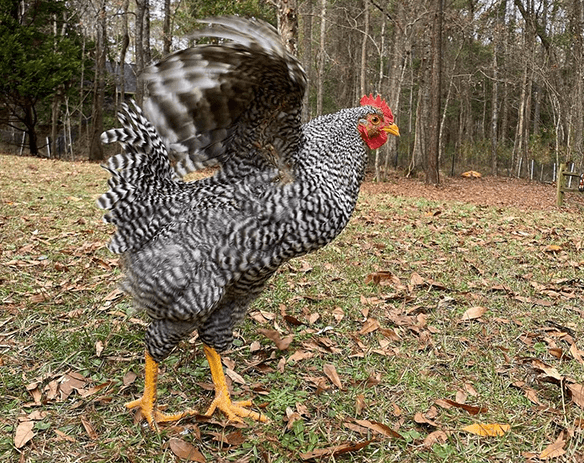
We all like our hens where they should be: inside the run, safely on the ground. But if you’ve ever seen pictures of a chicken roosting in a tree, you already know chickens CAN fly. But how far? Or how high? Are there breeds that can not fly?
Let’s find out!
We’ll start with the million-dollar question:
Can Chickens Fly?
Yes. But they aren’t very good at it.
Like all birds, chickens have wings and feathers. But as they belong to the Gallinaceous bird species, also called landfowl, they’re not likely to fly long distances. Domesticated chickens don’t tend to fly because of their large body mass and too short wingspan. Today’s chickens are bred for meat, which means their flight muscles are large and heavy, making it more challenging to flap their wings enough to lift their body weight in the air.
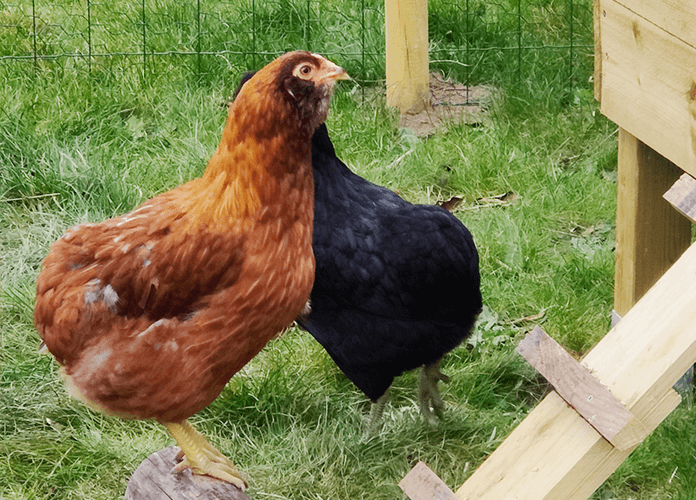
The longest recorded flight of a chicken is 13 seconds. In the wild, chickens only fly to escape a predator, roost or scrounge for food. But this doesn’t mean your backyard chickens can’t escape their chicken run by flapping over the fence. They can perform short, intensive flights to get them where they want to be.
Can all chicken breeds fly?
No. Heavy chicken breeds can’t fly, and neither can Silkies. Let’s find out why.
Heavy Breeds
Normal-sized chickens can fly short distances, but bigger-sized chickens like Orpingtons or Australorps have much more trouble flying because of their high body weight. Adult Orpingtons can weigh up to 8 pounds, so that they won’t fly out of your chicken run any time soon. They’ll jump and flap their wings to get to a higher place, like a roosting perch.
Silkies
Silkie chickens can’t fly, but it has nothing to do with their body weight, as silkies are a tiny breed. It has everything to do with their fluffy feathers, as silkie feathers look nothing like normal chicken feathers.
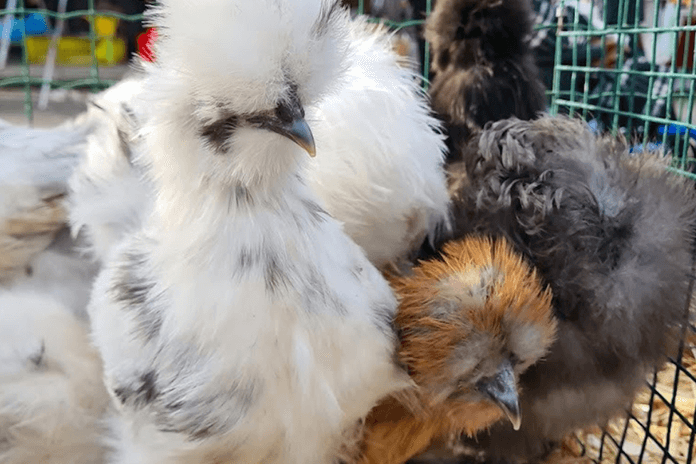
Normal feathers are smooth and have a thick shaft running down the center, with feather hairs growing on each side. These ‘hairs’ stick together, which creates a smooth and waterproof surface. Silkie feathers look entirely different as they lack the ability to stick together. This leaves all feather hairs separate and creates their distinguished fluffy look. Because their feather hairs don’t stick together, silkies cannot fly.
How High can chickens fly?
Chickens only fly to escape, find food, or roost. They’ll seldom fly directly to the point they want to end up. For example, if you see a chicken on a high tree branch, chances are, it took a couple of turns to get there. They fly from one branch to another until they are completely satisfied with their location. Or, more commonly, if your hen wants to escape the chicken run, she’ll probably jump or fly on top of the fence first before landing on the other side.
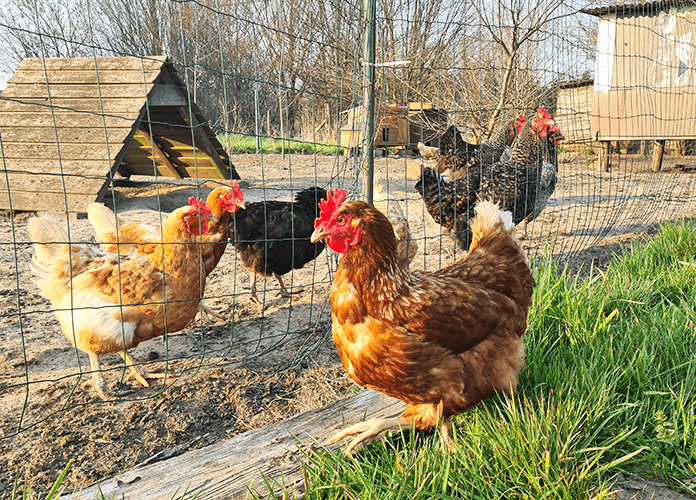
Because of this flying habit, it’s hard to determine the height chickens can fly. Some chicken keepers tell stories about their chickens flying up to 12 feet high, which sounds possible.
Can Chickens Fly Over A Fence?
Of course, they can. But that doesn’t necessarily mean they’ll fly over the fencing. Chickens can jump, fly or flap their wings just enough to get up and over a fence.
If you choose not to free-range your chickens, make sure the fence is high enough so they can’t jump over it. Escaping chickens can cause issues. They’ll ruin your freshly planted vegetable, herb, or ornamental garden. Or they cause trouble at your neighbor’s premises and are very vulnerable to predators.
How high should a Chicken Run fence be?
Depending on the chicken breeds you own, you’ll need a higher or less high fence. As addressed before, some breeds can not fly or jump very high, like Silkies or Orpingtons. So you don’t need to provide a very high fence when owning these types of chickens.
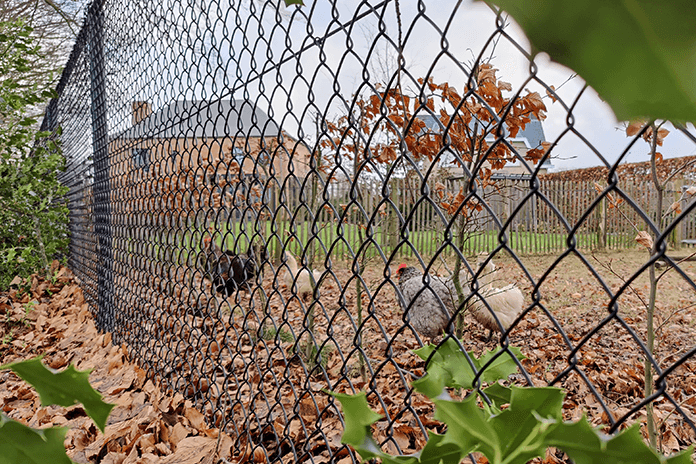
Other breeds with smaller body mass and small breeds like bantams can fly over a 6-foot fence when they’re determined to do so. Provide a minimum of 6 feet of fencing; you can expand to 8 feet if your chickens are eager to escape the run. But when you have a ‘frequent flyer’ on your hands, it’s easier to cover the chicken run with netting instead of installing a higher fence.
How to prevent a chicken from escaping the chicken run?
- Clipping wings
- Taller fencing
- Covering the chicken run
Clipping Wings
The most common practice to stop your chickens from escaping is clipping their wings. You can choose to cut just one wing or both, although it’s suggested chiefly to clip only one wing. Clipping chicken wings isn’t that hard to do. Plenty of DIY videos can be found online, and it doesn’t hurt your chicken. It’s like clipping a fingernail.
However, clipping your chickens’ wings does not prevent their ‘flight mode’; it reduces efficiency. Some chickens can be determined to escape the coop and free-ranging somewhere you don’t want them to be.
Taller Fencing
When clipping wings does not prevent the escaping of your chickens, you have to work on the infrastructure of the chicken run. Make the fence taller and make the chicken run bigger. The bigger the space, the less your chickens feel the need to escape. Plus, it makes it harder for them to jump on top of the fence from a ‘high’ area inside the run, like the coop roof or a shelter.
Make sure your chicken run meets minimum space requirements. Use our chicken coop space calculator, both for inside and outside space. A fence needs to be at least 6 feet tall, but you can expand to 8 feet if necessary.
Covering The Chicken Run
Covering the chicken run isn’t only necessary to protect the flock from predators like hawks; it keeps your chickens inside the run at all times.
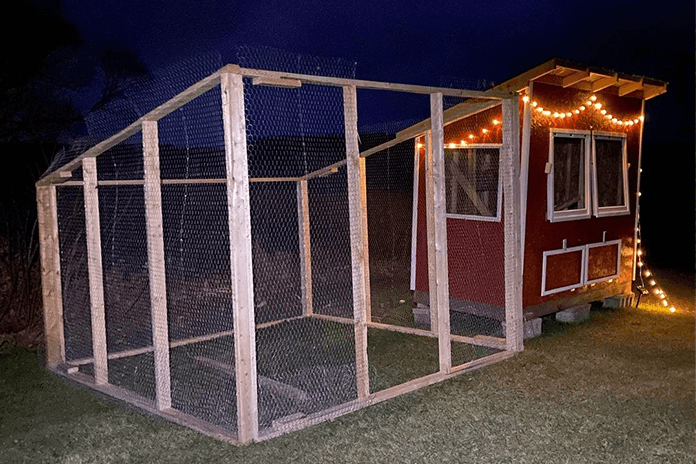
Depending on your budget and ease of maintenance, you can use any kind of roofing or netting you like, such as chain link wire, mesh, plastic roofing, hardware cloth, etc… Covering your run is a relatively easy and cheap way to prevent your chickens from flying or jumping over the fence.
To sum things up
Yes, chickens can fly. And some breeds fly better than others. Securing the chicken run is the best solution if you want your chickens to stay grounded. Or you can keep non-flyers such as silkies of heavyweight breeds.
Credits Featured Image: @sylvia0223 (IG)



















